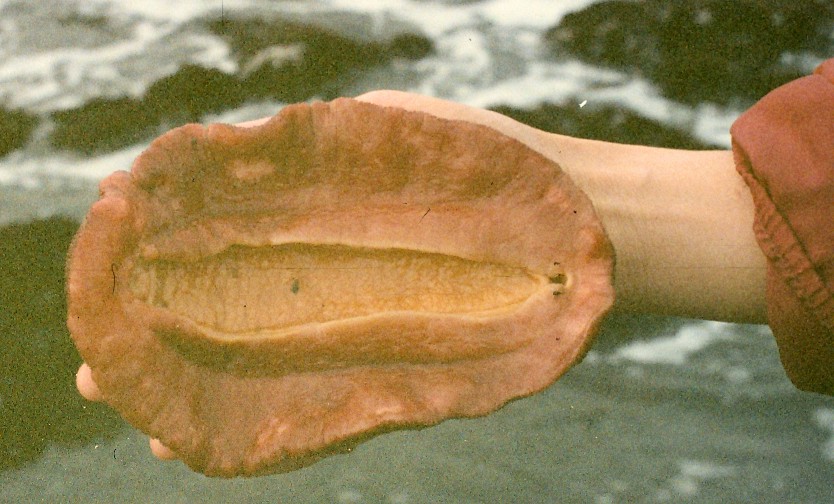Cryptochiton stelleri Middendorff, 1847Common name(s): Giant gumboot chiton, Giant Pacific chiton, Chinese slipper |
|
| Synonyms: |  |
| Phylum Mollusca
Class Polyplacophora Order Neoloricata Suborder Acanthochitona Family Acanthochitonidae |
|
| Cryptochiton stelleri San Simeon, CA | |
| (Photo by: Dave Cowles, 1995) | |
How to Distinguish from Similar Species: No other chiton in this area has all 8 plates covered by the mantle, nor grows this large.
Geographical Range: Aleutian Islands to San Nicolas Island, CA, Kamchatka, Kurile Islands, Japan
Depth Range: Low intertidal to 20 m
Habitat: Rocky substrate, especially in kelp beds.
Biology/Natural History: As with all chitons, this species can grip the rocks tightly. Its grip is not nearly as strong for its size as is that of many other species, however. With work one can usually dislodge it. Unlike some other chiton species, Cryptochiton stelleri has well-developed ctenidia (gills) in the pallial groove beside the foot. They often raise the edge of their mantle when in air, perhaps to facilitate respiration. The commensal polychaete worms Arctonoe vittata or A. pulchra can sometimes be found in their pallial groove, as can the pea crab Opisthopus transversus. O'clair and O'Clair do not report any commensals in this species in SE Alaska, however. The species spawns from March to May in California., laying eggs in gelatinous, cinnamon-red spiral strings up to 1 m long. The egg strings do not stick and are quickly broken up by the waves. When females release their eggs, nearby males are stimulated to release sperm into the water. After hatching, larvae swim for about 20 h before settling. Adults do not move far (less then 20 m in 2 years in one experiment) and may live 20 years or more. Some individuals have algae growing on their mantle. Feeds mostly on various red algae, and also on some brown and green algae. Predators include the snail Ocenebra lurida and tidepool sculpins. Sea otters seem to ignore it, but river otters will eat it.. Indian tribes often ate it. 44% of body weight is blood. The radular teeth are hardened with a magnetite cap. Named after Georg Wilhelm Steller, an early Russian naturalist in Alaska.
The radular teeth
of gumboot chitons contain magnetite (a very hard, magnetic iron-containing
compound) and are one of the hardest biomaterials made (Nemoto
et al., 2019). Photos and movies of gumboot chiton radular
teeth in action can be seen here
and
here.
| Return to: | |||
| Main Page | Alphabetic Index | Systematic Index | Glossary |
References:
Dichotomous Keys:Kozloff 1987, 1996
Smith and Carlton, 1975
Flora and Fairbanks, 1966
General References:
Morris
et al., 1980
Kozloff,
1993
O'Clair
and O'Clair, 1998
Scientific Articles:
Nemoto,
Michiko, Dongnei Ren, Steven Herrera, Songqin Pan, Takashi Tamura, Kenji
Inagaki, and David Kisailus, 2019. Integrated transcriptomic and proteomic
analyses of a molecular mechanism of radular teeth biomineralization in
Cryptochiton stelleri. Scientific Reports 9: Article 856. doi: 10.1038/s41598-018-37839-2.
General Notes and Observations: Locations, abundances, unusual behaviors:

The underside of this species is composed of a flat foot with a row of gills along each side (gills not visible in this photo). The edges of the mantle form a wide belt around the foot.
Photographed by Dave Cowles at San Simeon, CA 1995

Another photo of the underside. Photo by Dave Cowles, San Simeon,
CA April 1997
This species was formerly abundant at San Simeon, CA. During the
latter years of the 1990's I (Dave Cowles) observed large numbers decomposing
and washing up onto the beach. I suspect a disease was affecting
them. Those washing ashore were blotched, as some living individuals
are. I wonder if the blotching seen in living individuals is a sign
of disease? Far fewer can be found there now. I also notice that
it is not unusual to see blotched and dying individuals washed up on other
beaches.
Authors and Editors of Page:
Dave Cowles (2005): Created original page